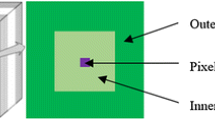Abstract
In the field of hyperspectral image processing, anomaly detection (AD) is a deeply investigated task whose goal is to find objects in the image that are anomalous with respect to the background. In many operational scenarios, detection, classification and identification of anomalous spectral pixels have to be performed in real time to quickly furnish information for decision-making. In this framework, many studies concern the design of computationally efficient AD algorithms for hyperspectral images in order to assure real-time or nearly real-time processing. In this work, a sub-class of anomaly detection algorithms is considered, i.e., those algorithms aimed at detecting small rare objects that are anomalous with respect to their local background. Among such techniques, one of the most established is the Reed–Xiaoli (RX) algorithm, which is based on a local Gaussian assumption for background clutter and locally estimates its parameters by means of the pixels inside a window around the pixel under test (PUT). In the literature, the RX decision rule has been employed to develop computationally efficient algorithms tested in real-time systems. Initially, a recursive block-based parameter estimation procedure was adopted that makes the RX processing and the detection performance differ from those of the original RX. More recently, an update strategy has been proposed which relies on a line-by-line processing without altering the RX detection statistic. In this work, the above-mentioned RX real-time oriented techniques have been improved using a linear algebra-based strategy to efficiently update the inverse covariance matrix thus avoiding its computation and inversion for each pixel of the hyperspectral image. The proposed strategy has been deeply discussed pointing out the benefits introduced on the two analyzed architectures in terms of overall number of elementary operations required. The results show the benefits of the new strategy with respect to the original architectures.













Similar content being viewed by others
References
Reed, I.S., Yu, X.: Adaptive multiple-band CFAR detection of an optical pattern with unknown spectral distribution. IEEE Trans. Acoust. Speech Signal Process. 38(10), 1760–1770 (1990)
Stein, D.W.J., Beaven, S.G., Hoff, L.E., Winter, E.M., Schaum, A.P., Stocker, A.D.: Anomaly detection from hyperspectral imagery. IEEE Signal Process. Mag. 19(1), 58–69 (2002)
Ashton, E.A.: Detection of subpixel anomalies in multispectral infrared imagery using an adaptive Bayesian classifier. IEEE Trans. Geosci. Remote Sens. 36(2), S06–S17 (1998)
Carlotto, M.J.: A cluster-based approach for detecting man-made objects and changes in imagery. IEEE Trans. Geosci. Remote Sens. 43(2), 374–387 (2005)
Chang, C.-I., Du, Q.: Estimation of number of spectrally distinct signal sources in hyperspectral imagery. IEEE Trans. Geosci. Remote Sens. 42(3), 608–619 (2004)
Chang, C-l: Orthogonal subspace projection (OSP) revisited: a comprehensive study and analysis. IEEE Trans. Geosci. Remote Sens. 43(3), S02–S18 (2005)
Du, Q., Nkovei, R.: Fast real-time onboard processing of hyperspectral imagery for detection and classification. J. Real Time Image Process. 4(3), 273–286 (2009)
Skauli, T., Haavardsholm, T.V., Kasen, I., Arisholm, G., Kavara, A., Opsahl, T.O., Skaugen, A.: An airborne real-time hyperspectral target detection system. Proc. SPIE 7695, A1–6 (2010)
Tarabalka, Y., Haavardsholm, T.V., Kasen, I., Skauli, T.: Realtime anomaly detection in hyperspectral images using multivariate normal mixture models and GPU processing. J. Real Time Image Process. 4(3), 287–300 (2009)
Park, K.S., Cho, S.H., Hong, S., Cho, W.D.: Real-time target detection architecture based on reduced complexity hyperspectral processing. EURASIP J. Adv. Signal Process. (Article ID 438051), 1–14 (2008)
Bing Zhang, et al.: Real-time target detection in hyperspectral images based on spatial-spectral information extraction. EURASIP J. Adv. Signal Process. 2012, 142
Stellman, C.M., Hazel, G.G., Bucholtz, F., Michalowicz, J.V., Stocker, A., Schaaf, W.: Real-time hyperspectral detection and cuing. Opt. Eng. 39(7), 1928–1935 (2000)
Eismann, M.T., Stocker, A.D., Nasrabadi, N.M.: Automated hyperspectral cueing for civilian search and rescue. Proc. IEEE 97(6), 1031–1055 (2009)
Stevenson, B., O’Connor, R., Kendall, W., Stocker, A., Schaff, W., Holasek, R., Even, D., Alexa, D., Salvador, J., Eismann, M., Mack, R., Kee, P., Harris, S., Karch, B., Kershenstein, J.: The civil air patrol ARCHER hyperspectral sensor system. Proc. SPIE 5787, 17 (2005)
Acito, N., Matteoli, S., Diani, M., Corsini, G.: Complexity-aware algorithm architecture for real-time enhancement of local anomalies in hyperspectral images, pp. 1861–8200. Springer, Berlin (2011)
Hunt, B.R., Cannon, T.M.: Non-stationary assumptions of Gaussian models of images. IEEE Trans. Syst. Man Cybern 6, 876–881 (1976)
Acito, N., Corsini, G., Diani, M.: Adaptive detection algorithm for full-pixel targets in hyperspectral images. IEE Proc. Vis. Image Signal Process. 152(6), 731–740 (2005)
Kwon, H., Der, S.Z., Nasrabadi, N.M.: Adaptive anomaly detection using subspace separation for hyperspectral imagery. Opt. Eng. 42(11), 3342–3351 (2003)
Richards, J.A., Jia, X.: Remote sensing digital image processing. Springer, New York (1993)
Matteoli, S., Diani, M., Corsini, G.: A tutorial overview of anomaly detection in hyperspectral images. IEEE Aerosp. Electron. Syst. Mag. 25(7), 5–28 (2010)
Tapia, R.A., Lanius, C.,:Computational science: tools for a changing world. Rice University, (2001), [http://ceee.rice.edu/Books/CS/index.html]
Golub, G.H., Van Loan, C.F.: Matrix computations, 3rd Edn, John Hopkins University Press (1996)
Molero, J.M., Garzon, E.M., Garcia, I., Plaza, A.: Anomaly detection based on a parallel kernel RX algorithm for multicore platforms. J. Appl. Remote Sens. 6, 061503 (2012)
Acito, N., Diani, M., Corsini, G., Residual striping reduction in hyperspectral images, 17th international conference on digital signal processing, 1–7, 2011
Acito, N., Diani, M., Corsini, G.: Subspace-based striping noise reduction in hyperspectral images. IEEE Trans. Geosci. Remote Sens. 49(4), 1325–1342 (2011)
Matteoli, S., Acito, N., Diani, M., Corsini, G.: An automatic approach to adaptive local background estimation and suppression in hyperspectral target detection. IEEE Trans. Geosci. Remote Sens. 49(2), 790–800 (2011)
Author information
Authors and Affiliations
Corresponding author
Rights and permissions
About this article
Cite this article
Rossi, A., Acito, N., Diani, M. et al. RX architectures for real-time anomaly detection in hyperspectral images. J Real-Time Image Proc 9, 503–517 (2014). https://doi.org/10.1007/s11554-012-0292-3
Received:
Accepted:
Published:
Issue Date:
DOI: https://doi.org/10.1007/s11554-012-0292-3




